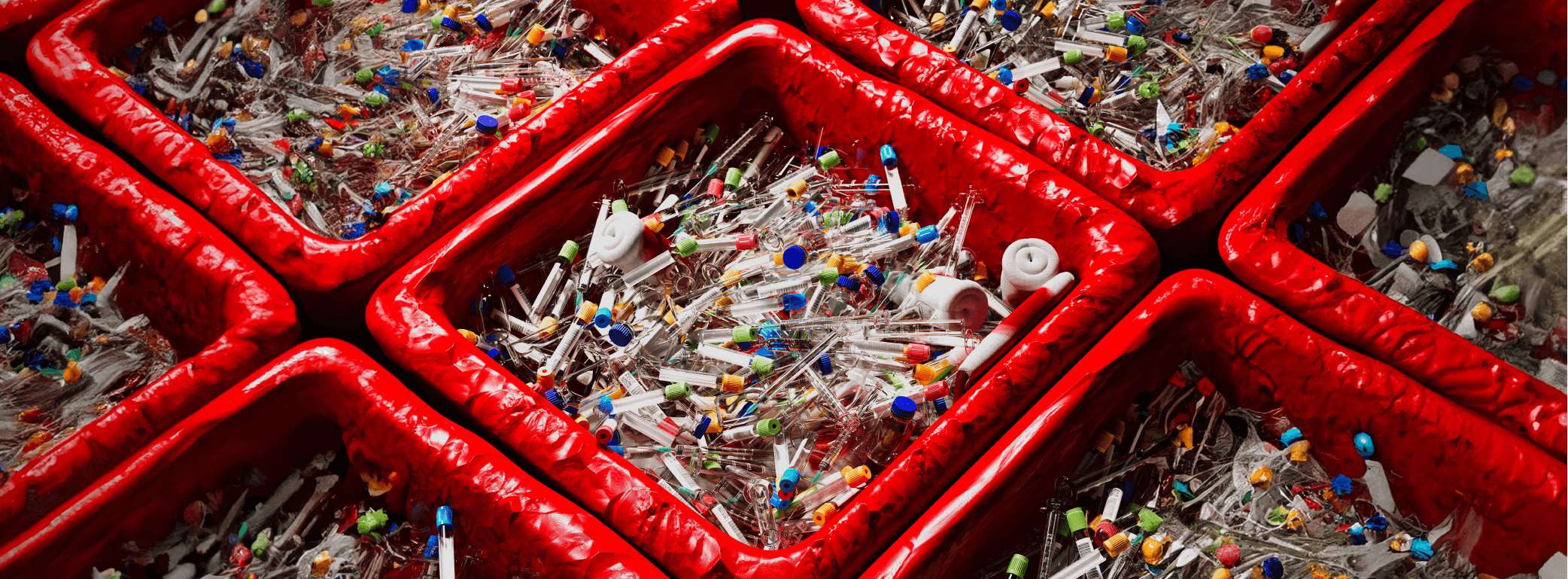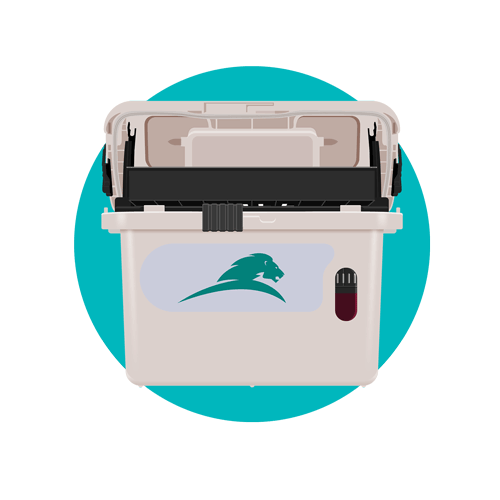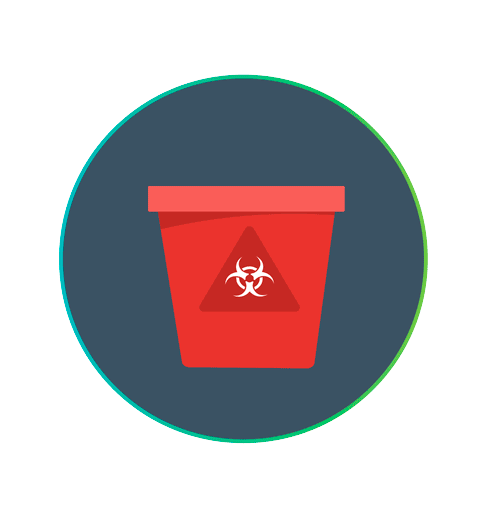Where Does Biohazardous Waste Go?

Today we’ll explore where biohazardous waste goes upon disposal, highlighting the importance of proper management for safety and compliance.
TOPICS WE WILL COVER:
1 / The Basics: Biohazardous Waste Definition
2 / The Importance of Proper Biohazard Disposal & Management
3 / How to Dispose of Biohazard Waste and Where it Goes
4 / Who is Responsible For Biohazard Waste Management?
5 / Why Choose Daniels Health for Biohazardous Waste Removal?
6 / Our Innovations in Biological Waste Solutions
7 / Maximize Safety and Compliance With the Experts in Biohazardous Waste
The Basics: Biohazardous Waste Definition
Biohazardous waste–essentially defined as any solid waste or liquid waste contaminated with blood, human body fluids, or other materials that could potentially spread infections–presents significant health risks if mishandled. This type of waste includes materials contaminated with infectious agents or potentially infectious substances. Examples of biohazardous waste include a wide range of items, from blood and blood products; contaminated PPE, IV tubing, cultures and stocks of infectious agents; waste from patients with communicable diseases; to other medical supplies like used needles, scalpels and even pathological waste materials from biopsies.
The Importance of Proper Biohazard Waste Disposal & Management
The careful handling and disposal of biohazardous waste is paramount, safeguarding not only healthcare and laboratory personnel but also the wider community and environment. The journey of biohazardous waste, from its inception to final disposal, requires strict adherence to protocols that prevent the potential spread of infections. Materials soaked in blood or bodily fluids, for example, call for segregation and placement in designated biohazard waste containers, clearly labeled to avert risks of contamination.
The regulations of bodies such as The Occupational Safety and Health Administration (OSHA) mandate the proper labeling, storage, and disposal of biohazard waste to minimize infection risks and environmental damage. The consequences of neglecting these protocols extend beyond health hazards, potentially leading to legal repercussions, regulatory sanctions, and negative media attention.
How to Dispose of Biohazard Waste and Where it Goes
Disposing of biohazard waste requires an understanding of its categories and adherence to safety protocols. Biohazard waste can be divided into sharps, liquid, and solid categories, each requiring specific disposal practices to mitigate risks to public health and the environment.
Sharps Biohazard Waste
Sharps biohazard waste includes items like needles and scalpels—capable of piercing skin and potentially carrying infectious agents. Safe disposal involves placing these items in puncture-resistant, rigid containers, which should be permanently sealed and picked up by a biohazard waste disposal contractor when three-quarters full. Treated sharps waste typically ends up in a sanitary landfill after autoclaving.
Solid Biohazard Waste (non-sharps)
Solid biohazard waste (non-sharps) refers to items contaminated with specimen materials, such as gloves, PPE, and lab plastics. These items must be secured in clearly labeled containers that meet regulatory standards for biohazardous materials (such as being leak-proof). Although some hospitals have the capability to autoclave or incinerate this waste onsite, the majority would need to rely on specialized services. Therefore, these containers are typically collected by a licensed biohazard waste removal company, which ensures the waste is properly treated—either by autoclaving or incineration—to neutralize any biological hazards before final disposal. Ultimately, treated solid biohazardous waste will also be directed to landfills, ensuring minimized environmental and health risks.
Liquid Biohazard Waste
Liquid biohazard waste encompasses blood, body fluids, and microbial cultures. This type of liquid waste should be collected in sealable, leak-proof containers, clearly marked with a biohazard label. Prior to disposal, liquid biohazard waste requires treatment and is typically disposed of via sanitary sewer systems, ensuring it does not mix with solid waste streams.
Who is Responsible for Biohazard Waste Management?
The management of biohazardous waste is governed by the “cradle to grave” principle, which places the responsibility for this type of waste on the shoulders of the entity that generates it.
 This responsibility encompasses the entire lifecycle of the waste, from its initial generation through to its ultimate disposal. The Resource Conservation and Recovery Act (RCRA) authorizes the Environmental Protection Agency (EPA) to oversee the management of hazardous waste under this principle. It mandates that generators of biohazardous waste—whether they are healthcare facilities, laboratories, or any other entity producing such waste—must adhere to strict guidelines covering the generation, transportation, treatment, storage, and final disposal of their waste.
This responsibility encompasses the entire lifecycle of the waste, from its initial generation through to its ultimate disposal. The Resource Conservation and Recovery Act (RCRA) authorizes the Environmental Protection Agency (EPA) to oversee the management of hazardous waste under this principle. It mandates that generators of biohazardous waste—whether they are healthcare facilities, laboratories, or any other entity producing such waste—must adhere to strict guidelines covering the generation, transportation, treatment, storage, and final disposal of their waste.
Understanding and complying with both state and federal regulations concerning biohazard waste management is critical for these generators. These regulations are designed to prevent the risk of infection to workers, visitors, and the general population, as well as to minimize the potential release of hazardous substances into the environment. The EPA, through RCRA, established a regulatory framework that not only aims to ensure the safe handling and disposal of hazardous waste but also promotes practices that reduce the volume of such waste generated and encourage its beneficial reuse.
Why Choose Daniels Health for Biohazardous Waste Removal?
Choosing Daniels Health for biohazard waste removal means partnering with a leader in safe and compliant waste management solutions. Daniels Health offers a comprehensive suite of containers designed for the effective segregation of biohazard waste alongside specialized disposal services tailored to the needs of healthcare and related industries. With a commitment to safety and environmental protection, Daniels Health equips facilities of all sizes with the necessary tools and knowledge to manage biohazard waste responsibly, in full compliance with federal and state regulations.
Our Innovations in Biological Waste Solutions
 Daniels Health is proud to produce innovative biohazard waste containers engineered to provide maximum safety and efficiency. Features such as leak-proof construction and tamper-proof seals ensure that waste is contained securely, minimizing risks of spills and unauthorized access. The odor-lock technology keeps the surrounding environment free from unpleasant smells, enhancing workplace conditions.
Daniels Health is proud to produce innovative biohazard waste containers engineered to provide maximum safety and efficiency. Features such as leak-proof construction and tamper-proof seals ensure that waste is contained securely, minimizing risks of spills and unauthorized access. The odor-lock technology keeps the surrounding environment free from unpleasant smells, enhancing workplace conditions.
The benefits of these containers extend beyond safety. They are also environmentally friendly, thanks to their reusable design, which dramatically cuts down on the need for single-use plastics, aligning with our commitment to sustainability.
Daniels Health also conducts our own autoclaving treatment. Utilizing Bondtech full vacuum steam autoclaves, Daniels facilities can treat large volumes of biological waste efficiently. This process subjects waste to high temperatures of 285°F under 30 psi pressure, ensuring thorough steam sterilization. Powered by natural gas, this autoclave treatment offers a safe, method for treating biohazard waste, significantly reducing the risk of contamination and infection.
Maximize Safety and Compliance With the Experts in Biohazardous Waste

Understanding where biohazardous waste goes, from generation to final disposal, is crucial for maintaining a safe and compliant environment. Proper biohazard waste disposal plays a pivotal role in preventing the risk of contamination and infection, safeguarding not only healthcare workers but also the community and the environment.
Daniels Health specializes in offering expert guidance and tailored solutions for biohazardous waste management. With our innovative containers and disposal and treatment methods, we’re equipped to help your facility achieve the highest standards of safety and compliance.
Contact us for professional biohazard waste disposal near you.
Let's Talk!
Your time is valuable, and we don’t want to play hard to get. You can either phone us directly on the details listed on our contact page, or feel free to fill out this short form and one of our team members will get back to you as quickly as possible.
